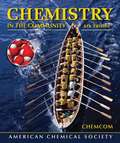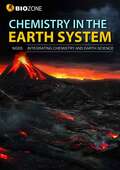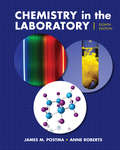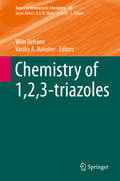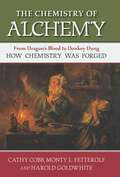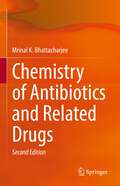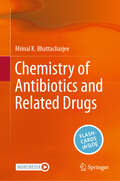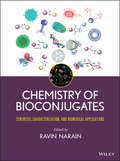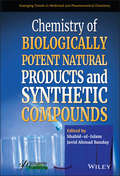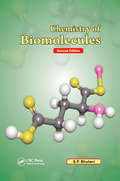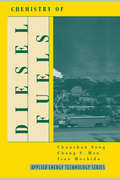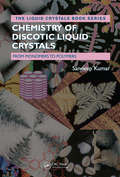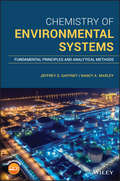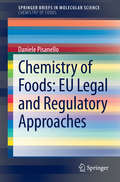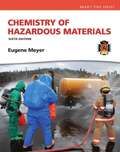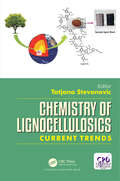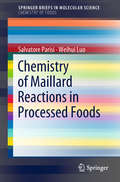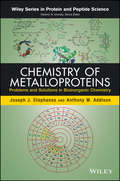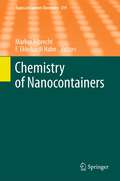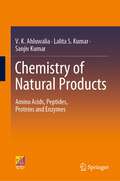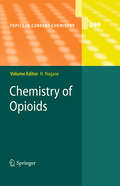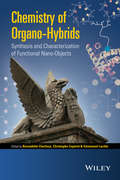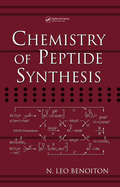- Table View
- List View
Chemistry in the Community (ChemCom), Sixth Edition
by American Chemical SocietyThe book offers a meaningful and memorable chemistry program for all levels of high school students and covers traditional chemistry topics within the context of societal issues and real-world scenarios. Centered on decision-making activities where students are responsible for generating data in an investigating, analyzing that data and then applying their chemistry knowledge to solve the presented problem.
Chemistry in the Community: Chemcom
by American Chemistry SocietyNIMAC-sourced textbook <P><P>Touted as the most successful NSF-funded project published, Chemistry in the Community (ChemCom) by the American Chemical Society (ACS) offers a meaningful and memorable chemistry program for all levels of high school students. ChemCom covers traditional chemistry topics within the context of societal issues and real-world scenarios. Centered on decision-making activities where students are responsible for generating data in an investigating, analyzing that data and then applying their chemistry knowledge to solve the presented problem. The text is intensively laboratory-based, with all 39 of the investigations integrated within the text, not separate from the reading. With the ChemCom program, students learn more organic and biochemistry, more environmental and industrial chemistry, and more on the particulate nature of matter than other textbooks all within the relevance of solving problems that arise in everyday life. <P><P>Meticulously updated to meet the needs of today's teachers and students, the new sixth edition of ChemCom adheres to the new science framework as well as the forthcoming next generation of science standards. Incorporating advances in learning and cognitive sciences, ChemCom’s wide-ranging coverage builds upon the concepts and principles found in the National Science Education Standards. Correlations are available showing how closely aligned ChemCom is to these and other state standards
Chemistry in the Earth System
by Tracey Greenwood Richard Allan Kent Pryor Lissa BainbridgeChemistry in the Earth System has been designed and written following the High School Three-Course Model for California. It will also suit NGSS-aligned states integrating Earth Science with Chemistry. This phenomena-based title takes a three-dimensional approach to provide an engaging, relevant, and rigorous program of instruction. Departing from the more traditional approach of BIOZONE’s Non-Integrated Series, the Integrated Series offers a learning experience based on the 5 Es and anchored in student-relevant phenomena and problems. Contents Combustion and Energy Transfer Heat and Energy in the Earth System Atoms, Elements, and Molecules Chemical Reactions Chemistry of Climate Change The Dynamics of Chemical Reactions & Ocean Acidification Basic skills for chemistry students
Chemistry in the Laboratory (Eighth Edition)
by Anne Roberts James M. PostmaFor nearly 40 years, Chemistry in the Laboratory has been meeting the needs of teachers and students. This new edition builds on that legacy while addressing cutting-edge trends in the chemistry laboratory—including forensic chemistry and environmental and green chemistry. As always, the new edition of Chemistry in the Laboratory offers precise, easy-to-follow instructions, helpful illustrations, and an emphasis throughout on laboratory safety. Again, throughout, a Consider This feature encourages users to expand the principles of the experiment into interesting applications, open-ended experiments, or unexplored corners. Most experiments in the manual can be completed in one lab session, but some can be linked or extended for a multi-lab project.
Chemistry of 1,2,3-triazoles (Topics in Heterocyclic Chemistry #40)
by Wim Dehaen Vasiliy A. BakulevThe series Topics in Heterocyclic Chemistry presents critical reviews on present and future trends in the research of heterocyclic compounds. Overall the scope is to cover topics dealing with all areas within heterocyclic chemistry, both experimental and theoretical, of interest to the general heterocyclic chemistry community. The series consists of topic related volumes edited by renowned editors with contributions of experts in the field.
Chemistry of Alchemy: From Dragon's Blood to Donkey Dung, How Chemistry Was Forged
by Cathy Cobb Harold Goldwhite Monty FetterolfA unique approach to the history of science using do-it-yourself experiments along with brief historical profiles to demonstrate how the ancient alchemists stumbled upon the science of chemistry. Be the alchemist! Explore the legend of alchemy with the science of chemistry. Enjoy over twenty hands-ondemonstrations of alchemical reactions. In this exploration of the ancient art of alchemy, three veteran chemists show that the alchemists' quest involved real science and they recount fascinating stories of the sages who performed these strange experiments. Why waste more words on this weird deviation in the evolution of chemistry? As the authors show, the writings of medieval alchemists may seem like the ravings of brain-addled fools, but there is more to the story than that. Recent scholarship has shown that some seemingly nonsensical mysticism is, in fact, decipherable code, and Western European alchemists functioned from a firmer theoretical foundation than previously thought. They had a guiding principle, based on experience: separate and purify materials by fire and reconstitute them into products, including, of course, gold and the universal elixir, the Philosophers' stone. Their efforts were not in vain: by trial, by error, by design, and by persistence, the alchemists discovered acids, alkalis, alcohols, salts, and exquisite, powerful, and vibrant reactions--which can be reproduced using common products, minerals, metals, and salts. So gather your vats and stoke your fires! Get ready to make burning waters, peacocks' tails, Philosophers' stone, and, of course, gold!
Chemistry of Antibiotics and Related Drugs
by Mrinal K. BhattacharjeeThis textbook builds on the success of the earlier edition, offering alternative strategies for discovering new antibiotics. It discusses how the various types of antibiotics and related drugs work to cure infections. Then it delves into the very serious matter of how bacteria are becoming resistant to these antibiotics. It also covers the global action plan on antimicrobial resistance from the World Health Organization and discusses several Antibiotic Stewardship Programs adopted by agencies at local levels. Appropriate for a one-semester course at either the graduate or advanced undergraduate level, the book is self-contained and written in accessible language. It includes all necessary background biochemistry material and a discussion of the latest developments in the field of antibiotics. Original research works are frequently cited and experimental procedures and interpretation of results are emphasized.
Chemistry of Antibiotics and Related Drugs
by Mrinal K. BhattacharjeeThis textbook builds on the success its two previous editions, offering alternative strategies for discovering new antibiotics. It discusses how the various types of antibiotics and related drugs work to cure infections, and explores the very serious matter of how bacteria are becoming resistant to these antibiotics. It also covers the global action plan on antimicrobial resistance from the World Health Organization and discusses several Antibiotic Stewardship Programs adopted by agencies at local levels. Designed for a one-semester course at either the graduate or advanced undergraduate level, this self-contained textbook provides all the necessary background in biochemistry and is written in accessible language. It discusses the latest developments in the field of antibiotics, emphasizing experimental procedures and interpretation of results, and frequently cites original research to support learning. To help both students and instructors, the book includes approximately 500 multiple-choice questions on antibiotcs. Test your knowledge with questions and answers about this textbook with Springer Nature Flashcards.
Chemistry of Bioconjugates
by Ravin NarainExplores bioconjugate properties and applications of polymers, dendrimers, lipids, nanoparticles, and nanotubesBioconjugation has enabled breakthroughs across many areas of industry and biomedicine. With its emphasis on synthesis, properties and applications, this book enables readers to understand the connection between chemistry and the biological application of bioconjugated materials. Its detailed descriptions of methods make it possible for researchers to fabricate and take full advantage of bioconjugates for a broad range of applications. Moreover, the book sets the foundation for the development of new applications, including assays, imaging, biosensors, drug delivery, and diagnostics.Chemistry of Bioconjugates features contributions from an international team of leading experts and pioneers in the field. These contributions reflect the authors' firsthand laboratory experience as well as a thorough review of the current literature. The book's six sections examine:General methods of bioconjugationPolymer bioconjugatesOrganic nanoparticle-based bioconjugatesInorganic nanomaterial bioconjugates, including metals and metal oxidesCell-based, hydrogel/microgel, and glyco-bioconjugatesCharacterization, physico-(bio)chemical properties, and applications of bioconjugatesThis comprehensive exploration of bioconjugates includes discussions of polymers, dendrimers, lipids, nanoparticles, and nanotubes. References at the end of each chapter serve as a gateway to the most important original research findings and reviews in the field.By drawing together and analyzing all the latest chemical methods and research findings on the physico-chemical and biochemical properties of bioconjugates, Chemistry of Bioconjugates sheds new light on the significance and potential of bioconjugation. The book is recommended for organic and polymer chemists, biochemists, biomaterial scientists, carbohydrate chemists, biophysicists, bioengineers, and drug and gene delivery scientists.
Chemistry of Biologically Potent Natural Products and Synthetic Compounds (Emerging Trends in Medicinal and Pharmaceutical Chemistry)
by Shahid-Ul-Islam Javid Ahmad BandayIn view of their promising biological and pharmaceutical activities, natural product inspired and heterocyclic compounds have recently gained a reputation in the field of medicinal chemistry. Over the past decades, intensive research efforts have been ongoing to understand the synthesis, biochemistry and engineering involved in their preparation and action mechanisms. Several novel natural product derivatives, heterocyclic and other synthetic compounds, have been reported to have shown interesting biological activities including anticancer, antimicrobial, anti-inflammatory, anti-glycemic, anti-allergy and antiviral etc. Chemistry of Biologically Potent Natural Products and Synthetic Compounds provides up-to-date information on new developments and most recent medicinal applications of the natural products and derivatives, as well as the chemistry and synthesis of heterocyclic and other related compounds.
Chemistry of Biomolecules, Second Edition
by S. BhutaniAbout the Book: Biomolecules are those molecules that are involved in the maintenance and metabolic processes of all living organisms. This fully revised second edition offers extensive coverage of important biomolecules from organic chemistry point of view. The author discusses carbohydrates, amino acids, peptides, proteins, enzymes, pyrimidines, purines, nucleic acids, lipids, terpenoids and alkaloids. The various topics are described in simple, lucid language and the mechanisms of the reactions are explained wherever required. Ideal for upper level undergraduates, graduates and researchers. Features: The author discusses the basic organic chemistry of the main families of biomolecules. Gives comprehensive information on biogenic substances. Includes a new chapter on alkaloids. It is a one-stop work with complete information about important biomolecules. This second edition will now appeal to upper level undergraduates as well as graduates.
Chemistry of Diesel Fuels
by Chunsham SongThis edited work covers diesel fuel chemistry in a systematic fashion from initial fuel production to the tail pipe exhaust. The chapters are written by leading experts in the research areas of analytical characterization of diesel fuel, fuel production and refining, catalysis in fuel processing, pollution minimization and control, and diesel fuel additives.
Chemistry of Discotic Liquid Crystals: From Monomers to Polymers (Liquid Crystals Book Series)
by Sandeep KumarThe self-contained properties of discotic liquid crystals (DLCs) render them powerful functional materials for many semiconducting device applications and models for energy and charge migration in self-organized dynamic functional soft materials. The past three decades have seen tremendous interest in this area, fueled primarily by the possibility
Chemistry of Environmental Systems: Fundamental Principles and Analytical Methods
by Jeffrey S. Gaffney Nancy A. MarleyA modern guide to environmental chemistry Chemistry of Environmental Systems: Fundamental Principles and Analytical Methods offers a comprehensive and authoritative review of modern environmental chemistry, discussing the chemistry and interconnections between the atmosphere, hydrosphere, geosphere and biosphere. Written by internationally recognized experts, the textbook explores the chemistries of the natural environmental systems and demonstrates how these chemical processes change when anthropogenic emissions are introduced into the whole earth system. This important text: Combines the key areas of environmental chemistry needed to understand the sources, fates, and impacts of contaminants in the environment Describes a range of environmental analytical methodologies Explores the basic environmental effects of energy sources, including nuclear energy Encourages a proactive approach to environmental chemistry, with a focus on preventing future environmental problems Includes study questions at the end of each chapter Written for students of environmental chemistry, environmental science, environmental engineering, geoscience, earth and atmospheric sciences, Chemistry of Environmental Systems: Fundamental Principles and Analytical Methods covers the key aspects and mechanisms of currently identified environmental issues, which can be used to address both current and future environmental problems.
Chemistry of Foods: Eu Legal And Regulatory Approaches (SpringerBriefs in Molecular Science)
by Daniele PisanelloThis book concerns the EU legal and regulatory framework relating to Chemicals in Food. It is divided in two parts: the first section offers an introduction to the European General Food Law with an analysis of EFSA (the European Food Safety Authority) and a description of main features of food safety-related regulations. The second part focusses on the legislation finding application concerning chemicals in food from different viewpoints, namely: - the REACH regulation; - the enzyme, flavorings and additive regulatory framework; - the matter of contamination and veterinary drugs; - the use of Food contact materials. The final chapter addresses several considerations relating to chemical hazards and crisis management, highlighting shortcomings and lessons from experience.
Chemistry of Hazardous Materials
by Eugene MeyerChemistry of Hazardous Materials, Sixth Edition, covers basic chemistry for emergency responders, guiding students who are often non-science majors through the process of understanding the chemical properties that make materials hazardous. This text covers many essential hazardous materials topics, such as the Globally Harmonized System of Classification and Labeling of Chemical Substances (GHS); terrorist threats relative to biological, chemical, and radioactive agents; and the latest best practices for the handling and storage of hazardous materials. This new edition continues to emphasize the hazardous materials regulations established by the OSHA, the U.S. D.O.T., and the EPA.
Chemistry of Lignocellulosics: Current Trends
by Tatjana StevanovicThis book presents the chemical properties of lignocellulosic fibers, knowledge of which is essential for innovation and sustainable development of their transformation. Thermochemical transformation of wood and other lignocellulosics is presented to highlight its volatile, liquid and solid products and their novel applications. Forest biorefinery is described to emphasize the new products from lignocellulosic constituents, both structural (cellulose, hemicelluloses and lignins) and those extraneous to cell walls-extractives. New developments in cellulose technology related to nanocellulose are discussed in relation to new applications. Industrial lignins are presented in detail, both in terms of extraction procedures from spent liquors and structural characterization of the isolated lignins. Application of lignocellulosic biopolymers in new composite materials, or in biomaterials for medicinal purposes, and in solid wood preservation, are described. The example of an industrial biorefinery installed in southwestern France more than 40 years ago is presented.
Chemistry of Maillard Reactions in Processed Foods (Springerbriefs In Molecular Science)
by Salvatore Parisi Weihui LuoThis SpringerBrief explains the importance of Maillard reactions in food processing. It underlines that the term “Maillard reaction” actually does not describe one single chemical reaction, but an entire class of chemical reactions, which lead to browning, with a strong impact on visual appearance, odor, and flavor. It emphasizes that the Maillard reactions are still not fully characterized, despite extensive historical studies. While under the right conditions Maillard reactions have many favorable effects (e.g. formation of antioxidants), the Brief discusses that there are also conditions where Maillard reactions can result in toxic or mutagenic reactions. Hence, it emphasizes that the reaction should be viewed as a complex network of various sub-reactions, with a plethora of concomitant reaction mechanisms and kinetics. This Brief thus makes a step toward a holistic evaluation of the complexity of the Maillard reaction scheme, with the aim of making better and more targeted use in food processing.
Chemistry of Matter (Prentice Hall Science Integrated Learning System)
by Prentice-Hall StaffChemistry of Matter, Volume 1
Chemistry of Metalloproteins
by Joseph J. Stephanos Anthony W. Addisonith a list of suggested original research articles and reviews for further investigation of individual topics. Presenting our most current understanding of metalloproteins, Chemistry of Metalloproteins is recommended for students and researchers in coordination chemistry, biology, and medicine. Each volume of the Wiley Series in Protein and Peptide Science addresses a specific facet of the field, reviewing the latest findings and presenting a broad range of perspectives. The volumes in this series constitute essential reading for biochemists, biophysicists, molecular biologists, geneticists, cell biologists, and physiologists as well as researchers in drug design and development, proteomics, and molecular medicine with an interest in proteins and peptides.
Chemistry of Nanocontainers (Topics in Current Chemistry #319)
by Markus Albrecht F. Ekkehardt HahnMolecular Cages and Capsules with Functionalized Inner Surfaces, by Stefan Kubik. Drug Delivery by Water-Soluble Organ metallic Cages, by Bruno Therrien. Reversibly Expanded Encapsulation Complexes, by Dariush Ajami und Julius Rebek. Container Molecules Based on Imine Type Ligands, by A. Carina Schulze und Iris M. Oppel. Molecular Capsules Derived from Resorcin[4]arenes by Metal-Coordination, by Tobias Schröder, Satya Narayan Sahu und Jochen Mattay. Coronates, Spherical Containers, Bowl-Shaped Surfaces, Porous 1D-, 2D-, 3D-Metallo-Coordination Polymers, and Metallodendrimers, by Rolf W. Saalfrank und Andreas Scheurer.
Chemistry of Natural Products: Amino Acids, Peptides, Proteins and Enzymes
by V.K. Ahluwalia Lalita S. Kumar Sanjiv KumarThis book is designed to serve as a textbook for core as well as elective courses offered to undergraduate and advanced undergraduate students enrolled in chemistry. This textbook comprehensively deals various topics of organic chemistry such as amino acids, peptides, proteins and enzymes. The text is divided into four chapters: a chapter each dedicated to amino acids, peptides, proteins and enzymes, respectively. The important reactions have been explained with the help of the mechanisms involved. It gives a detailed account of the solution phase and solid phase synthesis of peptides as well as discussing the structure and function of some biologically important peptides. It also covers the classification, nomenclature and mode of action of enzymes, and a detailed account of the structure and function of different co-enzymes. The book also includes pedagogical features like end-of-chapter exercises to aid in self learning. Given the scope, this textbook will be useful for graduate and advanced graduate students pursuing the course of chemistry, especially organic chemistry.
Chemistry of Opioids (Topics in Current Chemistry #299)
by Hiroshi NagaseRecent Advances in the Synthesis of Morphine and Related Alkaloids; by N. Chida * Opioids in Preclinical and Clinical Trials; by H. Nagase and H. Fujii * Synthesis of 14-Alkoxymorphinan Derivatives and Their Pharmacological Actions; by H. Schmidhammer and M. Spetea * 14-Amino-4,5-Epoxymorphinan Derivatives and Their Pharmacological Actions; by J. W. Lewis and S. M. Husbands * Nonpeptidic Delta (δ) Opioid Agonists and Antagonists of the Diarylmethylpiperazine Class: What Have We Learned?; by S. N. Calderon * Synthesis of Neoclerodane Diterpenes and Their Pharmacological Effects; by K. M. Lovell, K. M. Prevatt-Smith, A. Lozama and T. E. Prisinzano * Synthesis of Novel Basic Skeletons Derived from Naltrexone; by H. Nagase and H. Fujii * Twin and Triplet Drugs in Opioid Research; by H. Fujii * 3D-Pharmacophore Identification for κ-Opioid Agonists Using Ligand-Based Drug-Design Techniques; by N. Yamaotsu and S. Hirono
Chemistry of Organo-hybrids
by Christophe Coperet Bernadette Charleux Emmanuel LacoteThis book provides readers with a one-stop entry into thechemistry of varied hybrids and applications, from a molecularsynthetic standpoint* Describes introduction and effect of organicstructures on specific support components (carbon-based materials,proteins, metals, and polymers).* Chapters cover hot topics including nanodiamonds,nanocrystals, metal-organic frameworks, peptide bioconjugates, andchemoselective protein modification* Describes analytical techniques, with pros and cons,to validate synthetic strategies* Edited by internationally-recognized chemists fromdifferent backgrounds (synthetic polymer chemistry, inorganicsurfaces and particles, and synthetic organic chemistry) to pulltogether diverse perspectives and approaches
Chemistry of Peptide Synthesis
by N. Leo BenoitonChemistry of Peptide Synthesis is a complete overview of how peptides are synthesized and what techniques are likely to generate the most desirable reactions. Incorporating elements from the author's role of Career Investigator of the Medical Research Council of Canada and his extensive teaching career, the book emphasizes learning rather th
